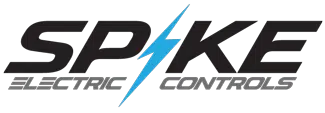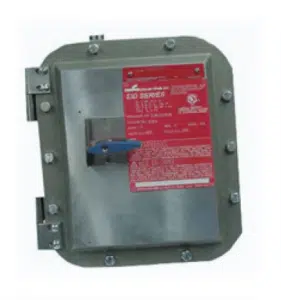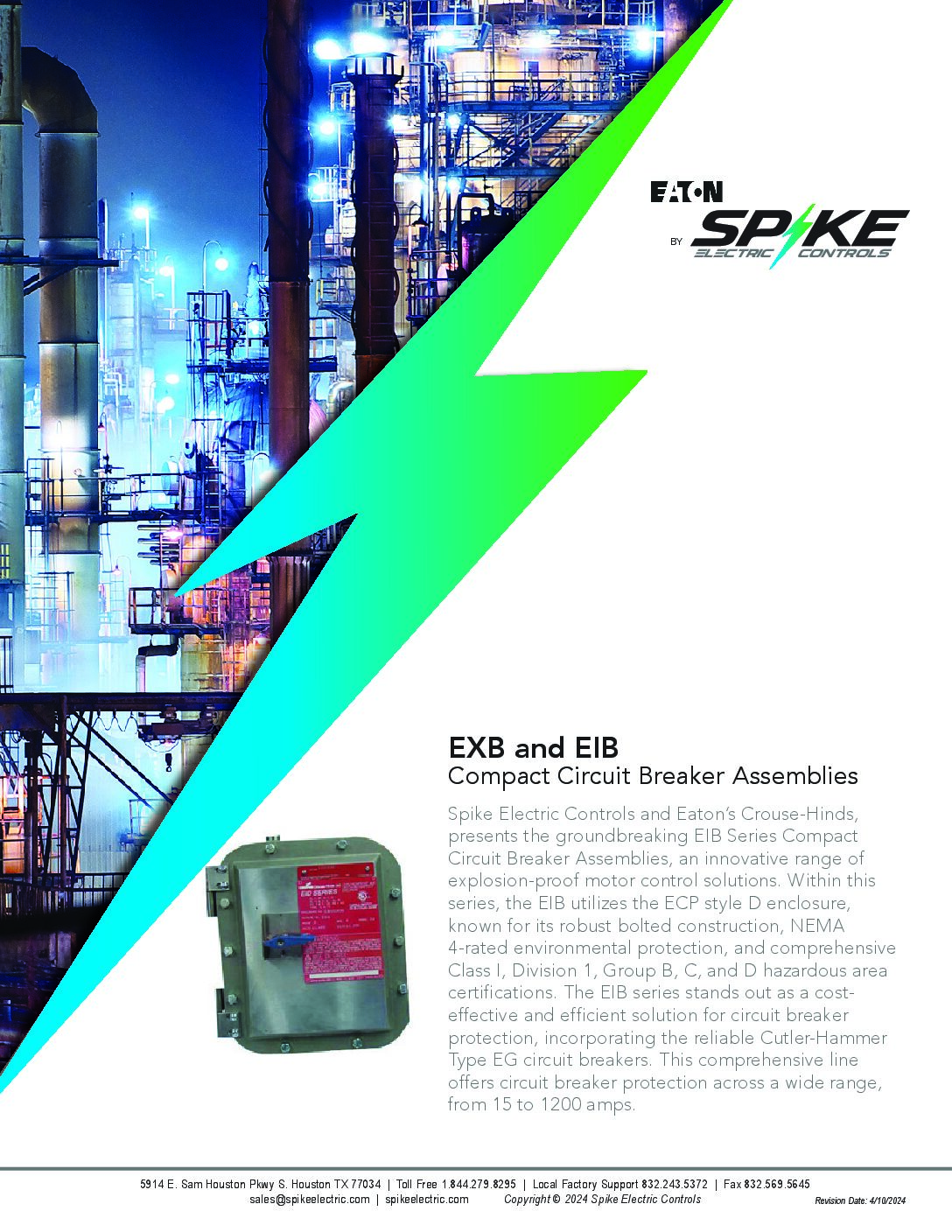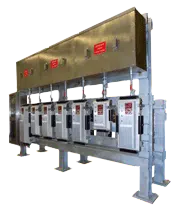EXB and EIB Explosion-Proof Circuit Breakers
Innovative Features of EXB and EIB Explosion-Proof Circuit Breakers
Designed for the utmost safety and reliability in hazardous environments, our
EXB and EIB Explosion-Proof Circuit Breakers embody innovation with their
compact design, ensuring efficient space use and durability against extreme
conditions. Equipped with clear operational indicators for immediate status
reports, these breakers blend technical sophistication with intuitive use, vital
for areas prone to explosive risks due to flammable gases, vapors, or dust.
Their specialized engineering prevents ignition in such volatile settings,
safeguarding personnel and infrastructure by containing any internal
explosions.
Technical Advantages & Options:
| Option | Code | Description |
| Auxiliary Contact (single block) | S784 | Provides a single auxiliary contact for external signaling or control functions. |
| Auxiliary Contacts (two blocks) | S785 | Offers two auxiliary contacts for enhanced external signaling or control capabilities. |
| Epoxy Powder Coat Finish (external only) | S752 | Applies a durable external coating for corrosion resistance and aesthetic appeal. |
| Epoxy Powder Coat Finish (internal and external) |
S753 | Protects both the internal and external surfaces against corrosion ANSI 61 Grey Epoxy Powder Coat. |
| External Ground Lug | S214 | Facilitates the connection of the breaker to the grounding system. |
| Red on Pilot light | J1 | Indicates the “on” status with a red light for clear, visual confirmation. |
| Green off Pilot light | J2 | Shows the “off” status with a green light for immediate visual feedback. |
| Custom Legend Plate (Specify Legend Markings) | NP | Allows for personalized labeling on the breaker for easy identification and operation |
| Substitute MCP for Breaker | SMCP | Enables the substitution of a Motor Circuit Protector (MCP) in place of the standard breaker. |
| Switching Neutral 4th pole | S4P | Adds a neutral pole that switches along with the other poles, suitable for certain application needs. |
| Switch for Breakereaker | SMCS | Provides an molded case switch with no trip unit in place of a breaker. This option is for applications requiring a non-fused disconnect. |
| Switch for Breakereaker | S87 | Allows the breaker to be tripped remotely through an applied external voltage signal. |
| Bell Alarm | S88 | Activates an audible alarm upon breaker trip, signaling attention is needed. |
Material Advantages:
| Material | Description | Advantages |
| Body & Cover – Copper-free aluminum | Aluminum alloy that does not contain copper. | Offers excellent corrosion resistance and high thermal and electrical conductivity, making it lightweight yet durable for protective enclosures. |
| Gasket – Neoprene | A synthetic rubber material. |
Provides superior sealing and resistance against aging, weathering, and ozone, as well as good chemical inertness. |
| Cover Bolts – Steel | Bolts made from steel for securing the cover. | Ensures strong, durable fastening with high tensile strength, capable of withstanding high loads and stresses. |
| Hinges – Stainless Steel | Hinges constructed from stainless steel. | Offers corrosion resistance and strength, ensuring longevity and reliability of the hinge mechanism under various environmental conditions. |
| Mounting Plate Sheet – Aluminum | A plate made from aluminum for mounting purposes. | Combines lightness with strength, providing an easy-to-work-with material that ensures durability and resistance to corrosion. |
Safety and Compliance Certifications:
This information is crucial for ensuring that equipment is suitable and safe for use in environments with explosive gases, dust, or fibers.
| Certification/Compliance | Description (EXB) | Description (EIB) |
| Class I, Divisions 1 & 2, Groups B, C, & D | Applies to environments where flammable gases, vapors, or liquids are present in sufficient quantities to produce explosive or ignitable mixtures. Classes B, C, and D specify the types of gases or vapors in the environment. | Identical to EXB. These certifications ensure the device is safe for use in areas with flammable gases, vapors, or liquids under normal or abnormal conditions. |
| Class I, Zones 1 & 2 | Not applicable to EXB. | Specifically applies to equipment that can safely operate in areas where hazardous gases, vapors, or liquids are likely to occur in sufficient quantities for ignition. Zone 1 indicates a high likelihood, while Zone 2 represents an area where such conditions are less likely. These are typically seen in IECEX or ATEX applications Spiek is an approved IECEX or ATEX manufacturer for Eaton Crouse Hinds Explosion Proof Products. |
| Class II, Division 1, Groups E, F, and G | Indicates suitability for locations with combustible dust. Groups E, F, and G categorize the dust types (metal, carbonaceous, and non-conductive, respectively). | Identical to EXB. This certification ensures the device can safely operate in dusty environments, which might combust under certain conditions. |
| Class III | Designates the device as safe for use in environments where fibers or flyings are present, but these materials are typically not in the air in sufficient concentrations to form ignitable mixtures | Identical to EXB. It implies that the equipment is suitable for use in textile mills, sawmills, and other sectors where fibers and flyings are present but not typically in explosive concentrations> |
| Enclosure Type 3, 3R, 4, 7BCD, 9EFG | These enclosure types are designed to withstand environments exposed to elements such as rain, sleet, snow, dust, and are explosion-proof in specified classifications. | Identical to EXB. The variety in enclosure types indicates versatility in protection against environmental conditions and explosive atmospheres, ensuring operational safety and durability in diverse settings. |
| NEMA 3, 3R, 4, 7BCD, 9EFG | Aligns with the Enclosure Type certifications, specifying standards for enclosures used in different environments to protect against ingress, corrosion, and damage from external ice formation. | Identical to EXB. The NEMA ratings provide a standardized level of protection for enclosures, indicating their suitability for various environmental conditions and hazardous locations. |
| cUL and UL Standard 1203 | Certifications from UL (Underwriters Laboratories) indicating that the equipment meets the requirements for safety and performance in hazardous locations. | Identical to EXB. These standards confirm that the equipment has been tested and certified to meet specific safety requirements, making it suitable for use in environments where explosive conditions may exist.td> |
Materials and Finishes Used:
1. Copper-free Aluminum – Natural
- Material: Copper-free Aluminum
- Copper-free aluminum refers to aluminum alloys that have a minimal copper content, typically less than 0.4%. This reduction in copper content significantly enhances the material’s resistance to corrosion, especially in marine and industrial environments where corrosion is a major concern.
- Aluminum, being lightweight yet strong, offers excellent electrical conductivity and is easy to shape and mold, making it ideal for a wide range of applications, including electrical components and enclosures.
- Finish: Natural
- The term “natural” in this context indicates that the aluminum surface is left in its original state without additional coatings or finishes. This finish benefits from aluminum’s inherent corrosion resistance and results in a product that is both lightweight and durable, with a clean, metallic appearance.
- Natural aluminum finishes are often chosen for their aesthetic appeal and the ability to withstand environmental conditions without significant degradation.
2. Steel – Electro-galvanized
- Material: Steel
- Steel is known for its strength and durability, making it a common choice for industrial and construction applications. It provides a robust framework or enclosure, ensuring the longevity and reliability of the equipment it is used to manufacture.
- Finish: Electro-galvanized
- Electro-galvanization involves applying a thin layer of zinc to the steel surface through an electrolytic process. This zinc coating acts as a protective barrier that prevents the underlying steel from rusting.
- The electro-galvanized finish enhances the corrosion resistance of steel, making it suitable for use in environments where moisture or corrosive agents are present. It also gives the steel a smooth and uniform appearance, which is beneficial for both aesthetic and functional purposes.
Summary: The choice of copper-free aluminum with a natural finish and steel with an electro-galvanized finish reflects a careful consideration of material properties and environmental demands. Aluminum offers a lightweight, corrosion-resistant option with good conductivity, ideal for electrical and marine applications. Electro-galvanized steel combines the inherent strength and durability of steel with enhanced corrosion resistance, making it suitable for a wide range of industrial applications. These materials and finishes ensure that the equipment can withstand harsh conditions without compromising performance or safety.
Applications and Industries Served:
The EIB and EXB Explosion-Proof Circuit Breakers represent a significant advancement in technology designed to offer unparalleled protection and performance in such conditions. These circuit breakers are engineered to meet the rigorous demands of various applications and industries, ensuring safety, compliance, and operational efficiency. This article delves into the diverse applications and industries served by these innovative products.
1. Chemical and Petrochemical Industries
- The chemical and petrochemical sectors are notorious for their hazardous conditions, including the presence of flammable gases, vapors, and liquids. The EIB and EXB circuit breakers are designed to operate safely in these environments, providing reliable electrical control and protection. They prevent electrical sparks from igniting volatile substances, ensuring plant safety and protecting workers from potential hazards.
- Oil and Gas
- In the oil and gas industry, the risk of explosions and fires is high due to the nature of the materials handled. These industries require robust electrical equipment capable of withstanding extreme conditions. EIB and EXB circuit breakers offer the necessary durability and explosion-proof features, making them ideal for use in drilling rigs, refineries, and distribution systems where safety cannot be compromised.
- Pharmaceuticals
- Pharmaceutical manufacturing involves processes that can produce explosive dust and vapors. Maintaining electrical safety in such environments is critical. The EIB and EXB circuit breakers provide effective solutions, ensuring that electrical systems operate safely, even in areas where combustible dust or vapors may be present, thus supporting the pharmaceutical industry’s stringent safety standards.
- Power Generation and Distribution
- Power plants and distribution systems often operate in challenging conditions, including exposure to hazardous gases and dust. The robust design of the EIB and EXB circuit breakers ensures they can withstand such environments, providing reliable protection against electrical faults and reducing the risk of fire and explosions in power generation and distribution facilities.
- Mining
- Mining operations are conducted in environments where explosive gases and dust are common. Electrical equipment used in these settings must be specially designed to prevent ignition of these substances. The explosion-proof characteristics of the EIB and EXB circuit breakers make them suitable for mining applications, offering the necessary safety and reliability.
- Marine and Offshore
- The marine and offshore sectors face unique challenges, including saltwater corrosion and the presence of explosive atmospheres. EIB and EXB circuit breakers are built to endure these harsh conditions, providing dependable electrical protection for ships, offshore platforms, and other marine applications.
- Manufacturing and Processing Facilities
- Manufacturing and processing facilities, especially those handling flammable materials, require electrical systems that prioritize safety and efficiency. The EIB and EXB circuit breakers are engineered to meet these requirements, ensuring safe operation across a wide range of manufacturing processes.
- Manufacturing and processing facilities, especially those handling flammable materials, require electrical systems that prioritize safety and efficiency. The EIB and EXB circuit breakers are engineered to meet these requirements, ensuring safe operation across a wide range of manufacturing processes.
- Agriculture and Grain Processing
- Agriculture and grain processing industries deal with high volumes of combustible dust. The EIB and EXB circuit breakers’ explosion-proof design is crucial in preventing fires and explosions caused by electrical sparks, offering a layer of protection to these vital sectors.
- Wastewater Treatment
- Wastewater treatment plants often contain hazardous gases such as methane, making explosion-proof electrical equipment a necessity. The EIB and EXB circuit breakers are capable of operating safely in such environments, ensuring the uninterrupted and safe treatment of wastewater.
The EIB and EXB Explosion-Proof Circuit Breakers are essential components for industries operating in hazardous environments. Their robust design and compliance with safety standards make them suitable for a wide range of applications, from chemical processing to marine exploration. By incorporating these circuit breakers into their electrical systems, industries can enhance safety, reduce the risk of explosions, and ensure operational continuity. As industries continue to evolve and face new challenges, the reliability and safety provided by the EIB and EXB circuit breakers will remain indispensable.
Custom Drilling and Tapping of Nema 7 Boxes:
A significant aspect of our specialization is the ability to perform custom drilling and tapping of conduit entries on electrical equipment while ensuring all UL and hazardous location ratings are meticulously maintained. This capability is underpinned by our dedicated team of hazardous location engineering specialists who design and engineer products that meet the stringent requirements of our clients, adhering to safety standards without compromising the integrity and functionality of the equipment.
Custom Drilled and Tapped NPT: An Overview
A custom drilled and tapped National Pipe Thread (NPT) refers to the creation of threaded holes in the bodies of electrical equipment, such as enclosures or fittings, designed to accept conduits or piping that follow the NPT standard. NPT is a U.S. standard for tapered threads used on threaded pipes and fittings. In hazardous locations, these custom modifications must be done with precision to ensure that the equipment remains explosion-proof and meets all relevant safety certifications.
Custom drilling and tapping provide the flexibility to modify standard electrical equipment to fit specific installation requirements, allowing for the direct connection of conduits in sizes or configurations that are not available off-the-shelf. This process is crucial for industries that require bespoke solutions to navigate the complexities of their operating environments, ensuring seamless integration of electrical systems while upholding safety and compliance standards.
Maintaining UL and Hazardous Location Ratings
Maintaining the integrity of UL and hazardous location ratings during custom modifications is paramount. Spike Electric achieves this through a rigorous engineering and quality assurance process, ensuring that all modifications are performed without compromising the explosion-proof and safety characteristics of the equipment. Our hazardous location engineering specialists meticulously design and supervise each custom modification to meet the specific requirements of hazardous environments, ensuring compliance with the highest safety standards.
Certification under the Eaton CAP Partnership
Spike Electric’s capability to offer these specialized services is supported by our certification under the Eaton Certified Assembly Partner (CAP) program. This partnership with Eaton, a global leader in power management technologies, signifies our commitment to excellence and adherence to rigorous quality standards in the assembly and modification of electrical products.
The Eaton CAP program is designed to ensure that certified partners like Spike Electric have the necessary expertise, processes, and facilities to customize Eaton’s extensive range of electrical products while maintaining their original certifications and compliance with safety standards. This includes the ability to perform custom drilling and tapping on conduit entries in a manner that upholds the integrity of the equipment’s hazardous location and safety ratings.
Conclusion
Spike Electric’s collaboration with Eaton through the CAP program enables us to provide our clients with customized electrical solutions that meet the exacting requirements of hazardous locations. Our team of engineering specialists leverages this partnership to design and engineer products that not only meet custom specifications but also ensure compliance with safety and performance standards. This unique capability allows industries operating in challenging environments to achieve their safety and operational goals, with the assurance that their electrical systems adhere to the highest standards of reliability and safety.
Various Names for NEMA 7 Disconnects:
• Explosion-Proof Disconnects
• Hazardous Location Disconnects
• Explosion-Proof Junction Disconnects
• Class I Division 1 Disconnects
• Flameproof Disconnects
• Hazardous Area Disconnects
• Intrinsically Safe Disconnects
• Explosion-Proof Electrical Disconnects
•Hazardous Duty Disconnects
• Classified Location Disconnects




